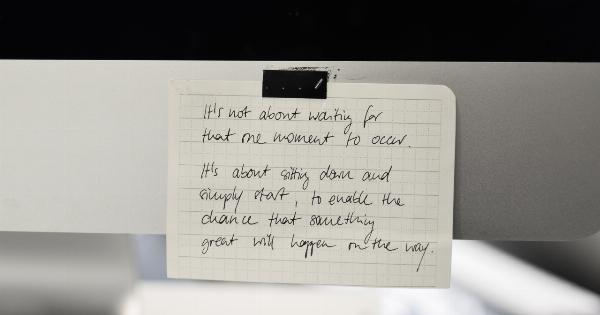Minor cuts and scratches can happen at any time, whether you are cooking, working outdoors, or simply going about your daily activities.
While these injuries may seem small, it is important to treat them properly to avoid infection or other complications. Here are some basic steps you can take to treat minor cuts and scratches:.
Clean the Wound
The first step in treating a cut or scratch is to clean the wound. Wash your hands thoroughly with soap and water, and then gently wash the affected area with soap and water. This will help remove any dirt or debris that may be present on the wound.
If the wound is bleeding, applying gentle pressure with a clean cloth or gauze may help stop the bleeding.
Apply a Topical Antibiotic
After the wound has been cleaned, apply a topical antibiotic cream or ointment to help prevent infection. These over-the-counter products are designed to kill bacteria and other microorganisms that may be present on the wound.
Be sure to follow the instructions on the product packaging carefully.
Cover the Wound
After applying the antibiotic cream or ointment, cover the wound with a sterile bandage or dressing. This will help keep the wound clean and protected while it heals.
If the wound is on an area that is likely to be exposed to dirt or other contaminants (such as your hands), you may need to change the bandage or dressing more frequently to ensure that the wound stays clean.
Monitor the Wound
It is important to monitor the wound for signs of infection or other complications. These may include redness, swelling, warmth, or drainage from the wound.
If you notice any of these symptoms, contact your healthcare provider for further evaluation and treatment.
Change the Bandage
You should change the bandage or dressing whenever it becomes wet or dirty. This will help ensure that the wound stays clean and dry, which is essential for proper healing.
Before changing the bandage or dressing, wash your hands thoroughly with soap and water.
Keep the Wound Elevated
If the wound is on your hand, arm, foot, or leg, keeping the affected limb elevated can help reduce swelling and promote healing. Use a pillow or other soft object to elevate the limb above your heart as much as possible.
Apply Ice to Reduce Swelling
If you notice swelling around the wound, you can apply ice to the affected area to help reduce inflammation. Wrap a bag of ice or a cold pack in a clean cloth and apply it to the wound for 10 to 15 minutes at a time, several times a day.
Take a Pain Reliever if Necessary
If the wound is causing you discomfort or pain, you can take an over-the-counter pain reliever such as acetaminophen or ibuprofen. Be sure to follow the instructions on the product packaging carefully.
Watch for Signs of Infection
Even with proper treatment, a minor cut or scratch can become infected. Watch for signs of infection, such as increased redness, swelling, warmth, or drainage from the wound. Other symptoms may include fever, chills, or a general feeling of malaise.
If you notice any of these symptoms, contact your healthcare provider for further evaluation and treatment.
When to Seek Medical Attention
While most minor cuts and scratches can be treated at home, there are some situations where medical attention may be necessary. You should seek medical attention if:.
- The wound is deep or gaping
- The wound is bleeding heavily and won’t stop
- You are unable to clean the wound or remove debris from the wound
- You have signs of infection (such as fever, chills, or red streaks around the wound)
- You have a pre-existing medical condition that affects your immune system (such as diabetes)
Conclusion
Proper treatment of minor cuts and scratches is essential to avoid infection and other complications. By following the basic steps outlined above, you can help ensure that your wound heals properly and without complications.
Remember to monitor the wound for signs of infection, keep the area clean and dry, and seek medical attention if necessary.





























